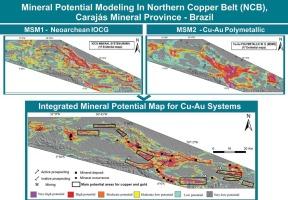绘制北铜带铜金矿物潜力(IOCG和铜金多金属),Carajás矿产省:数据驱动,基于矿物系统的方法
IF 3.6
2区 地球科学
Q1 GEOLOGY
引用次数: 0
摘要
虽然Carajás矿产省具有全球重要的成矿意义,但在找矿目标和人工智能方面的进展大大改善了矿产潜力的填图,但很少有区域尺度的研究对其进行评价。因此,我们在北部铜带进行了一项地区规模的研究,该地区拥有巴西最大的氧化铁-铜-金(IOCG)矿床Salobo。利用基于矿物系统的方法,我们开发了额外和隐伏的IOCG矿床的远景模型。圈定了两个铜系统:(i)在2.72 Ga和2.55 Ga具有多个矿化脉冲的iocg型系统;(ii)与古元古代a型花岗岩(~ 1.88 Ga)有关的花岗岩相关系统,与脆性构造中较小规模的Cu-Au多金属矿化有关。使用基于gis的空间建模和随机森林分类进行制图。关键的地质标准和证据图是基于地质、地球物理和矿产资源数据集。最终的地图描绘了高潜力的铜金带,几个重叠的已知矿床。结构框架和航空磁数据是最显著的预测因素。使用分层k-fold交叉验证的统计验证证实了模型的高准确性。最终的综合模型训练精度达到0.875(±0.20),测试精度达到0.866。使用改进的预测区域图进行空间验证进一步支持了模型的稳健性,所有已知事件都在研究区域的3.7%内捕获。现场验证证实了模型预测,增强了其可靠性。确定了几个新的高潜力带,但没有已知的矿床,并根据规模、连续性和有利性优先考虑了五个关键目标。这些结果加强了数据驱动的矿物系统方法在Carajás地区规模勘探中的有效性。本文章由计算机程序翻译,如有差异,请以英文原文为准。

Mapping Cu–Au mineral potential (IOCG and Cu–Au polymetallic) in the Northern Copper Belt, Carajás Mineral Province: A data-driven, mineral systems-based approach
Advances in exploration targeting and artificial intelligence have substantially improved mineral potential mapping, but few regional-scale studies have evaluated on the Carajás Mineral Province despite its global metallogenic importance. Hence, we conducted a district-scale study in the Northern Copper Belt, which hosts Brazil’s largest iron oxide–copper–gold (IOCG) deposit, Salobo. Using a mineral systems-based approach, we developed prospectivity models for additional and concealed IOCG deposits. Two copper systems were delineated: (i) an IOCG-type system with multiple mineralizing pulses at 2.72 Ga and 2.55 Ga, and (ii) a granite-related system associated with Paleoproterozoic A-type granites (∼1.88 Ga), linked to smaller-scale Cu–Au polymetallic mineralization in brittle structures. Mapping was performed using GIS-based spatial modeling and Random Forest classification. Key geological criteria and evidential maps were based on geological, geophysical, and mineral resource datasets. The resulting maps delineated high-potential Cu–Au zones, several overlapping known deposits. Structural frameworks and airborne magnetic data were the most significant predictive factors. Statistical validations using stratified k-fold cross-validation confirmed high model accuracies. The final integrated model reached 0.875 (±0.20) training accuracy and 0.866 in testing. Spatial validation using the improved Prediction–Area plot further supported the model’s robustness, with all known occurrences captured within 3,7% of the study area. Field validation corroborated model predictions, reinforcing its reliability. Several new high-potential zones without known deposits were identified, and five key targets were prioritized based on scale, continuity, and favorability. These results reinforce the effectiveness of a data-driven mineral systems approach for district-scale exploration in Carajás.
求助全文
通过发布文献求助,成功后即可免费获取论文全文。
去求助
来源期刊

Ore Geology Reviews
地学-地质学
CiteScore
6.50
自引率
27.30%
发文量
546
审稿时长
22.9 weeks
期刊介绍:
Ore Geology Reviews aims to familiarize all earth scientists with recent advances in a number of interconnected disciplines related to the study of, and search for, ore deposits. The reviews range from brief to longer contributions, but the journal preferentially publishes manuscripts that fill the niche between the commonly shorter journal articles and the comprehensive book coverages, and thus has a special appeal to many authors and readers.
 求助内容:
求助内容: 应助结果提醒方式:
应助结果提醒方式:


